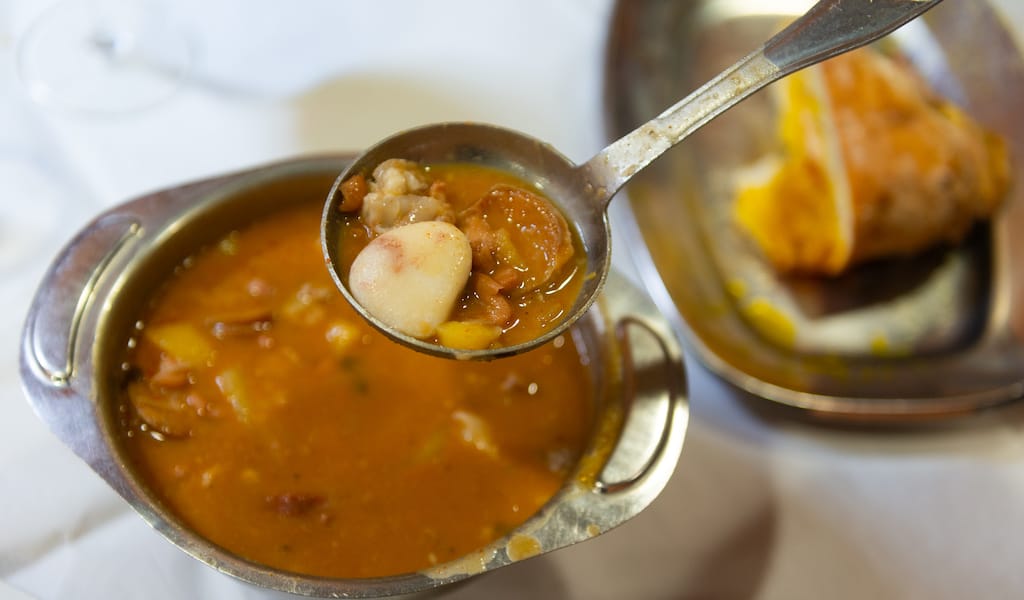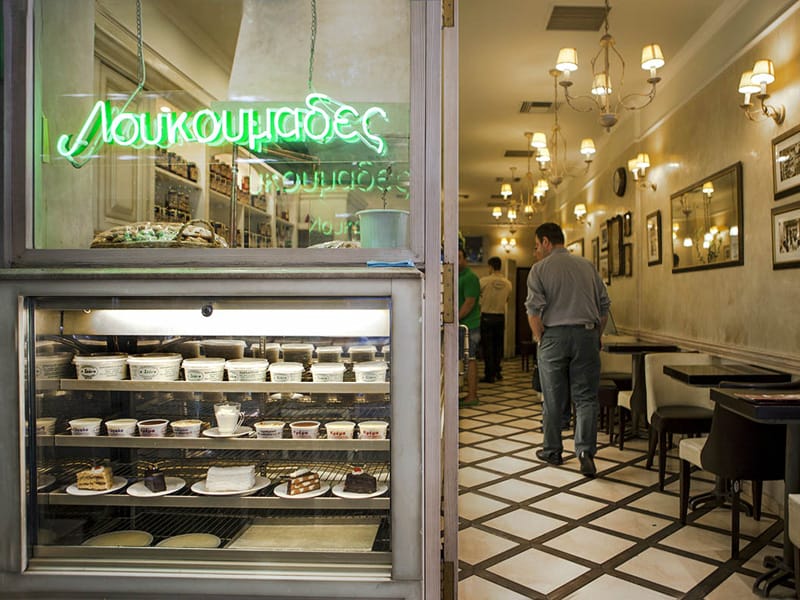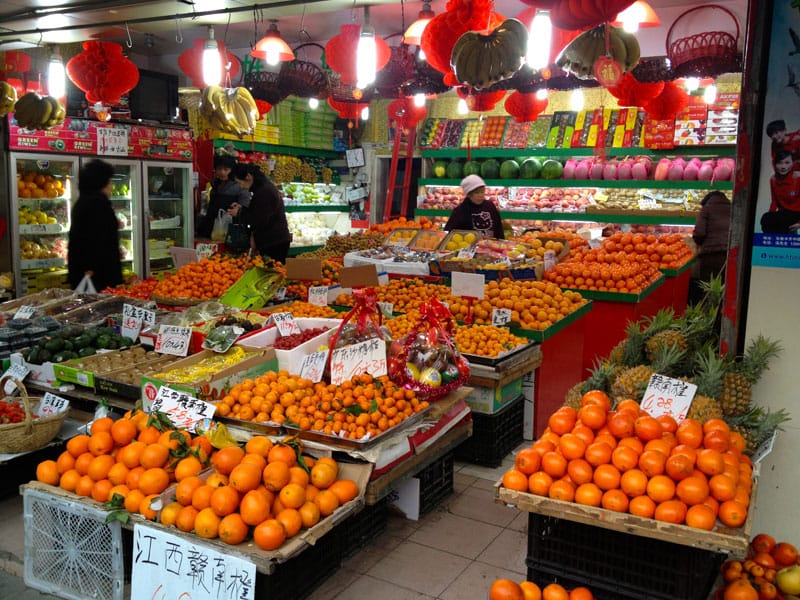It’s an early example of guilt tripping. The story goes that a monk arrived in a Portuguese village, hungry and clever. He grabbed a rock and carried it door to door, claiming that it was his only ingredient, asking people if they would be kind enough to supplement it so he could make a meal. Tugging on heartstrings in this manner, he was able to accumulate a pot, a potato, some beans, a bit of sausage and some salt-preserved pork and seasonings – a hodgepodge of ingredients that, along with that crucial stone, he united as soup. Thus, goes the story, sopa de pedra, “stone soup,” was born.
Hélia Costa, a restaurateur in Almeirim, an hour north of Lisbon, tells a much more practical origin story for the dish’s unique name.
“My grandparents had a small shop, and they would serve this soup there,” she tells us. “A customer said it was ‘dark as the cobblestones of the street.’”
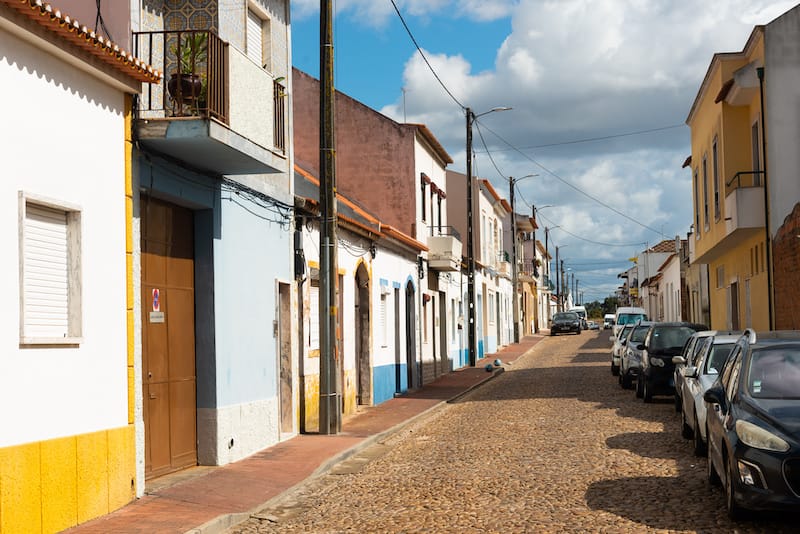
Even if that wandering monk really did exist, it’s likely that Hélia’s restaurant, O Toucinho, which dates back to 1962, was the first place to sell sopa de pedra. But she tells us that the dish was made in Almeirim long before this.
“It’s a dish from this region,” says Hélia. “It’s a rustic, agricultural area. People here raise pigs, grow potatoes – everyone has these ingredients.”
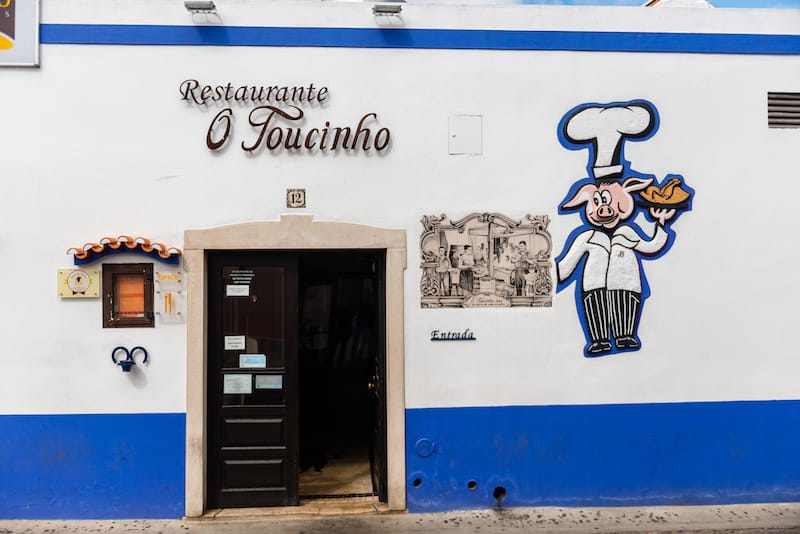
We are chatting with Hélia in the kitchen of O Toucinho as she ladles yet another serving of sopa de pedra from a massive 120-liter pot. As we talk, customers enter the restaurant, exiting with massive buckets filled with the soup (there’s a list of bucket-specific takeaway prices posted on the wall). It’s not yet noon, and already a line is forming outside.
Likely spurred on by both the legend of the monk and the success of O Toucinho, Almeirim has become a destination for sopa de pedra. Today, the town (population: approximately 12,000) is home to dozens of restaurants that serve the dish – Almeirim’s Associação de Restaurantes da Sopa da Pedra unites 14 different venues alone – and it’s home to a statue dedicated to that famous monk. In 2022, the dish achieved international recognition when the European Union granted “Sopa de Pedra de Almeirim” ETG (Especialidade Tradicional Garantida) status, a designation that serves to define the parameters of a dish or ingredient.
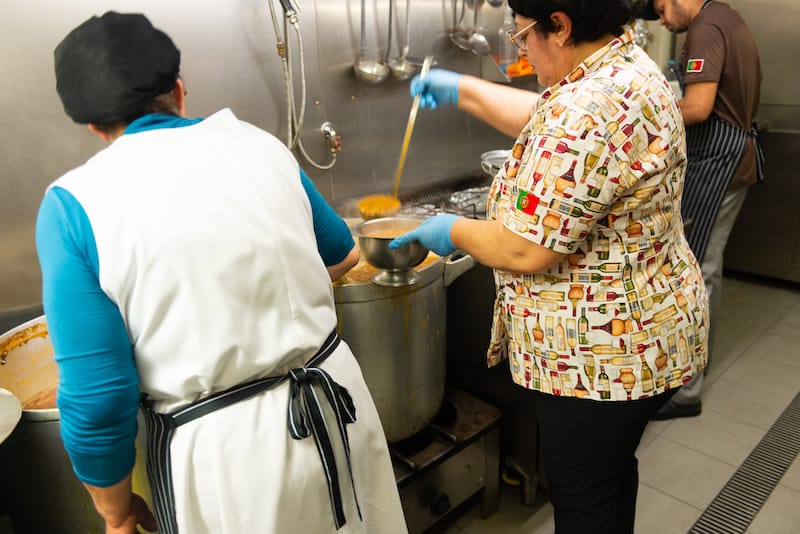
Hélia tells us that at O Toucinho the soup gets its start every morning at 6 a.m. when smoked and salt-preserved pork products (three types of sausage, cured pork belly and salted pig feet), pinto beans, onion, garlic, paprika powder, white pepper and bay leaf are put in one of those massive pots, topped with water, brought to a boil and allowed to simmer.
“We cook all the ingredients together at the same time – there’s no refogado,” says Hélia, referring to the almost obligatory Portuguese cooking technique of frying chopped onions and garlic in olive oil, a base for so many of the country’s dishes.
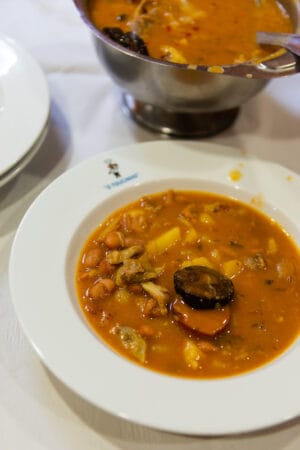 When the smoked meats are done, they’re removed and sliced. Cubed potatoes and chopped cilantro are added to the soup after this, and the dish is left to simmer until the beans have just started to break apart, the sharp edges of the potatoes have melted, and the collagen of the various meats has become intertwined with the broth.
When the smoked meats are done, they’re removed and sliced. Cubed potatoes and chopped cilantro are added to the soup after this, and the dish is left to simmer until the beans have just started to break apart, the sharp edges of the potatoes have melted, and the collagen of the various meats has become intertwined with the broth.
“The difference is in the cooking time,” says Hélia, without hesitation, when asked what makes the sopa de pedra at O Toucinho unique.
Hélia’s husband, João Simões, takes us around the restaurant – a massive, meandering establishment that can seat 200 diners – pointing out the tiny room that was once his parents-in-laws’ shop. The aesthetic of O Toucinho can be summarized in one word: bullfighting. Almerim is located in the province known officially as Ribatejo, unofficially as zona saloia (“the countryside”), and less pejoratively as Lezíria. Although located less than 100km from Lisbon, it’s a region with a distinctly rural feel, where bullfighters are heroes and where people still have a direct connection to the land.
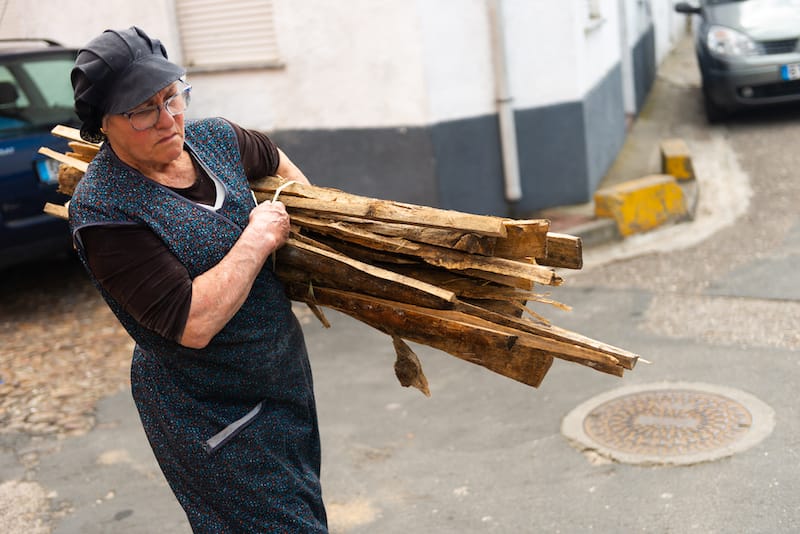
Simões takes us to the restaurant’s wood-burning oven, where staff are baking lumpy rolls known as caralhotas. To the ears of many Portuguese, at first hearing, the name of this bread sounds a bit racy (it sounds like “little dicks”). But Hélia tells us that it’s a local term for sweater pilling, a reference to the tiny bits of leftover dough that remain stuck to the bowl when baking. Names aside, the bread is simply delicious, with a crispy exterior and a pleasantly doughy interior, the perfect tool to sop up the rich broth.
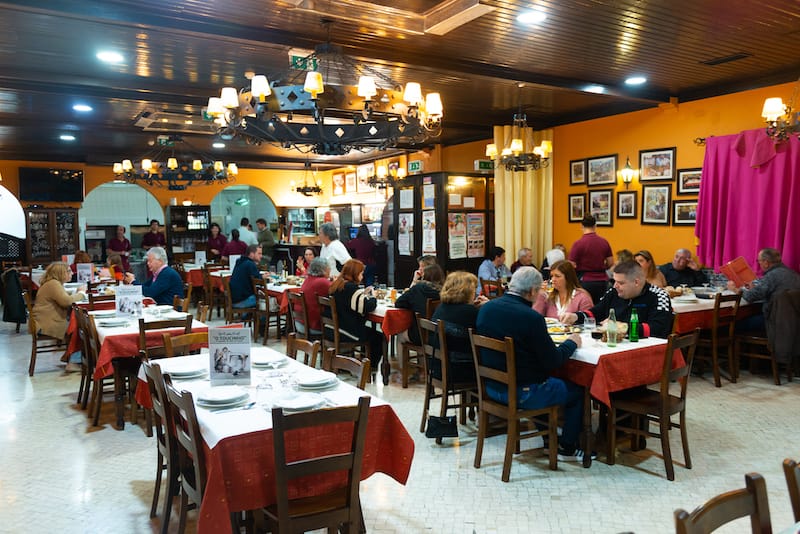
Simões then leads us to a semi-private dining room, where he leaves us with a small cauldron of sopa de pedra and a basket of caralhotas. We dig in, and are reminded of what Hélia had told us earlier: the long, slow cook causes the various ingredients to amalgamate and come together in a wonderfully cohesive way. No single element stands out, except for perhaps the aroma of cilantro – an attribute noted by legendary Portuguese food writer Maria de Lourdes Modesto, who was a fan of the sopa de pedra served at O Toucinho – and the result is savory, meaty, fragrant and silky all at the same time. And although we’ve consumed just about every last drop of the soup, a single element remains: that stone. One is added to every bowl, and tradition states that whoever is served the stone has to pay for the meal, a reminder of the generosity shared with that monk but bundled with much less guilt.
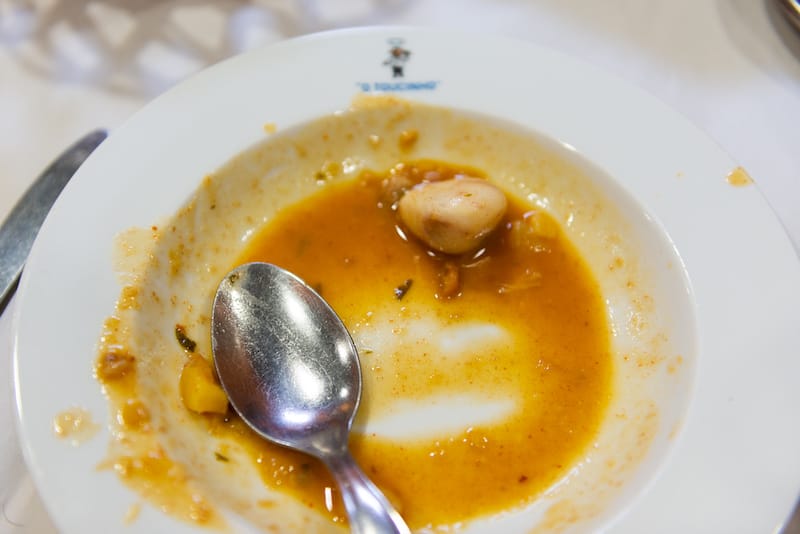
Almeirim is located around 100km north of Lisbon. It doesn’t have a train station, but it’s possible to take a train from Lisbon to neighboring Santarém, followed by a short taxi ride.
If you want to take a bit of Almeirim back with you and make sopa de pedra at home, a tiny shop directly next door to the restaurant O Forno sells all the requisite smoked meats (chouriço, morcela, farinheira, toucinho), as well as locally-grown pinto beans. Caralhotas can be bought at just about any restaurant in Almeirim or at Caralhotas da Caldeira, where Emília David has been recognized for the rolls that she bakes in her home-based, wood-burning oven.
 October 30, 2012 Stani
October 30, 2012 Stani
There are places that have been around so long that they've become emblematic of a […] Posted in Athens February 5, 2016 Auspicious Eating
February 5, 2016 Auspicious Eating
As the moon starts to wane each January, people throughout China frantically snatch up […] Posted in Shanghai April 1, 2021 CB on the Road
April 1, 2021 CB on the Road
Located less than 200 kilometers from Mexico City, Tequisquiapan is one of Mexico’s […] Posted in Mexico City
Austin BushAustin Bush
Published on May 11, 2023
Related stories
October 30, 2012
AthensThere are places that have been around so long that they've become emblematic of a city’s entire eating culture. In Athens, Stani (meaning "sheepfold" or "barnyard," depending on your definition) is certainly one of them. It may have a rustic-sounding name, but this wonderful, old-fashioned dairy bar – in business since 1931 – is an…
February 5, 2016
ShanghaiAs the moon starts to wane each January, people throughout China frantically snatch up train and bus tickets, eager to start the return journey to their hometown to celebrate the Lunar New Year (春节, chūnjié) with their family. This year, revelers will make an estimated 2.5 billion journeys on the train system alone, up 100 million from…
April 1, 2021
Mexico CityLocated less than 200 kilometers from Mexico City, Tequisquiapan is one of Mexico’s Pueblos Mágicos, or Magical Villages, places deemed to be rich in cultural traditions and symbolism by the country’s Secretariat of Tourism. Before Covid times, it was a favorite weekend getaway and a popular place to unwind. The “magical” qualities of the town…







































